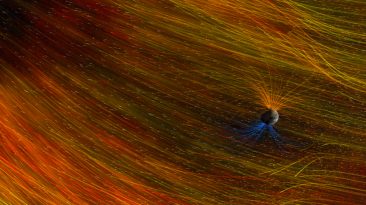Ashes and smoke cover the sky. Your hometown is sieged by massive wildfires. You rush to escape. Unaware that behind you, the wind and the heat have created a monster. A spinning tower of flames. In a few moments, it’ll swallow everything around it. Including you. What can a fire tornado lift? What will its blistering temperatures do to you? And how could you possibly escape one of them?
Technically speaking, a firenado isn’t really a tornado. Tornadoes extend from thunderstorms, so their vortex is in the sky. The vortex of a fire tornado, on the other hand, is formed by hot air on the ground. To do this, firenadoes need an intense source of heat like a fierce wildfire. The air warms up, the surrounding flames begin to rise, and a low-pressure area forms around it.
That causes even more air to rush in and fill the void. This column of hell then starts to rotate, pulling in embers, ash and flaming-hot gasses. Ta-da! You’ve got yourself a fire tornado. Not that it’s any good news. Sure. They look epic, but there’s a long list of reasons why they are nicknamed fire devils. So how big and strong can a firenado be?
Fire tornadoes only last for about 20 minutes. They’re also just a few meters wide. Height is more their thing. They can extend 10 to 50 m (33 to 164 ft) into the air. But the hotter the fire, the stronger they get. Some wildfires have produced firenadoes over 1,000 m (3,281 ft) tall. And their strength? They can have wind speeds of over 193 km/h (120 mph), all the way up to 240 km/h (150 mph).
They’ve been seen lifting all-terrain vehicles and a house with people still in it across a field. Fire devils live short lives, but they go all out. And one of these is about to do some serious damage to your town. Now you’d be facing a scorching tornado taller than the tallest building in the world. For the 20 minutes that it’ll be around, this fire devil would spark havoc on the streets.
Around you, roofs would be torn off houses.Trees would be pulled out of the ground, and cars lifted from the pavement like toys. You’d need to duck and cover. Because smaller objects are now missiles, darting through the air. Oh, and whatever the hot winds hadn’t snatched up could still burst into flames. Hope you don’t live near a gas station. Things could also get quite dire directly above you.
This firenado could raise a colossal plume of smoke, 5 km (3 mi) into the air. If afterward you heard thunder, it wouldn’t be your imagination. The intense heat could form a pyrocumulonimbus cloud. A thunderstorm cloud that can fuel the firestorm with dry lighting and by further spreading hot embers. And guess what these are also known to generate? Yup. More firenadoes.
So what would be your best bet at surviving? Run. Like your life depends on it. Because it does. Or better yet, find a car and put the pedal to the metal. Don’t even think about hiding in a basement, unless you want to end up trapped inside a burning building. Flying would also be dangerous. The firestorm could cause risky turbulence.
Whatever you choose, you’d better do it fast. A fire tornado can be especially dangerous because of how unpredictable it can be. It could turn and change directions at any second. Fail to escape and suddenly you’d be lifted off the ground and sucked straight into its fiery belly. Here temperatures can reach nearly 1,100 °C (2,000 °F).
Well, then you’d be toast. Your skin triggers a pain response at 44 °C (111 °F). Exposing it to anything above 48 °C (118 °F) for just five minutes can result in third-degree burns. Furiously spin at over 1,100 °C (2,000 °F) for almost 20 minutes, and the char will go beyond that. Your muscles would be cooked beyond well-done and your fat would sizzle and bubble.
Firenadoes like ’em crispy. By the time the firenado pulls you up to cooler air, you would have experienced sixth-degree burns. Only your charred bones would enjoy the relief of the cool breeze. And your blackened remains will hover, for a moment, over acres of scorched land and structures. Where hundreds could have also met your fate. Wow, that turned out a bit dark, didn’t it?
If you want to consider it an upside, you are far more likely to run into a traditional tornado than these destructive columns of fire. On the other hand, you also have better odds of witnessing a tornado hitting a hurricane.
Sources
- “8 Facts About The Biggest Tornadoes On Earth”. Dennis Mersereau. 2017. mentalfloss.com.
- “Whirling Flames: How Fire Tornadoes Work”. Marc Lallanilla. 2014. livescience.com.
- “To Survive A Firenado, Run Away”. Matt Power. 2018. greenbuildermedia.com.
- “Fire Tornadoes: Everything You Need to Know”. 2020. kin.com.
- “Fire Whirl | Skybrary Aviation Safety”. 2022. skybrary.aero.



























